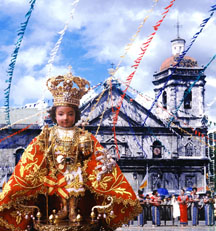The Santo Nino (Baby Jesus)
In April 1521, Portuguese explorer Ferdinand Magellan, in the service of Charles I of Spain, arrived in Cebu, Philippines during his voyage to find a westward route to the Indies.
He persuaded Rajah Humabon and his wife Hara Amihan, to pledge their allegiance to Spain. They were later baptized into the Catholic faith, taking the Christian names Carlos and Juana. Magellan gave Juana the Santo Nino as a symbol of the alliance. However, Magellan died during a dispute with tribes on Mactan Island.
 Santo Nino Statue and the Santo Niño Basilica in Cebu City |
The Spaniards returned to the Philippines in February 1565. Cebu was the settlement of Basque explorer Miguel López de Legazpi, who later founded Manila. He defeated Rajah Tupas, the chieftain of Cebu and nephew of Rajah Humabon, on April 27, and occupied the villages. The Santo Niño was found by Juan Camus a soldier of López de Legazpi, relatively unscathed in a burnt-out hut. This event was quickly acknowledged as miraculous, and a church was later constructed on the area of the discovery. Today, the Basilica Minore del Santo Niño is a historical and religious landmark in Cebu, with devotees forming long line up to pay their respects to the Holy Child.
The Santo Nino was considered to be the patron saint of Cebu. However, the Santo Niño is a representation of Jesus Christ as a child. The Catholic Church in the Philippines sets the Holy Child as an example of humility, and as a celebration of the Incarnation. Many Cebuanos do not consider the Christmas season over until the Feast of the Santo Niño.
In 2002, the Archbishop of Cebu, Ricardo Cardinal Vidal, declared Jesus' mother Mary, under the title of Our Lady of Guadalupe as the official patron saint of Cebu. This upset some of the Santo Nino followers, who felt that the declaration demoted the Holy Child. However, the declaration is consistent with Catholic thought requiring a patron saint be a human saint who has gone to his or her heavenly reward and who prays to God on behalf of the living, rather than a divine being himself.
Since the Holy Child is a representation of Jesus, the Second Person of the Trinity, he cannot, as God, be considered a patron. In that sense, Cardinal Vidal's move was to actually install a patron saint for Cebu, when before there was none. He did not, however, abolish the feast or the traditional mardigras parade.
Many still wonder whether the image enshrined at the Basilica Minore del Santo Nino is the original one brought by Magellan.
According to accounts, Magellan gave the image to Juana after the natives were baptized. Magellan was later killed while battling Lapu-Lapu and his men on Mactan.
Another Spanish expedition, under the leadership of Miguel Lopez de Legazpi, returned to Cebu in 1565.
After pillaging and razing a village, Legazpi’s soldiers found in a house spared in the fire an image of the child Jesus, similar in looks to the made-in-Flanders statue that Legazpi believed was given by Magellan more than 40 years earlier to the wife of the chieftain of Cebu. A church was then ordered built on the spot where the image was found. This church was elevated to the rank of a basilica during the 1965 celebration of the 4th centennial of the Christianization of the Philippines.
The Black Santo Nino
Extant pre-World War II photos show a black Santo Nino de Cebu. The Flanders creation Legazpi described should logically have Caucasian features. Adding to the mystery are local legends of a black Niño.
Where is this black image now? Heritage worker Ernesto Chua interviewed various personalities, partly to ascertain if the image venerated at the Basilica shrine is the original one.
Ernesto Chua’s research revealed that during the colonial period, the image of the Santo Niño de Cebu was painted black. Many parts of the country venerate darkly hued icons, such as the Black Nazarene of Quiapo, Our Lady of Good Voyage in Antipolo, and the Virgen de la Regla in Lapu-Lapu City. Even in Europe, dark Marian images are venerated. Yet there are no conclusive findings accounting for the dark Santo Niño de Cebu.
The Augustinians brought the image to the convent of the Redemptorists for safekeeping. An Augustinian priest asked a Belgian nun of St. Theresa’s College to wipe clean the face of the image. According to Chua’s research, part of the black paint was scraped off, revealing the original fair complexion. When the image was returned to the church after the war, the Augustinians commissioned anthropologist Dr. Mimi Trosdal to restore the image to its original color. A caretaker appointed to change the vestments and clean the icon, Trosdal told Chua she scraped off the black paint of the Santo Nino de Cebu and restored it between 1948 and 1949.
There is no doubt that the image enshrined at a chapel at the left side of the Basilica is indeed the original image that Magellan brought with him in his expedition and gave to the wife of Rajah Humabon, the king of Cebu.
Because of the original icon’s antiquity, only replicas are used during the fluvial parade and the foot procession held a day before the Sinulog Grand Festival. Security comes into play also as the original image is adorned with precious stones and jewelry.
|
|
| Advertise | | Share This Site | | Archive | | Privacy Policy |
Return from Santo Nino to Home





